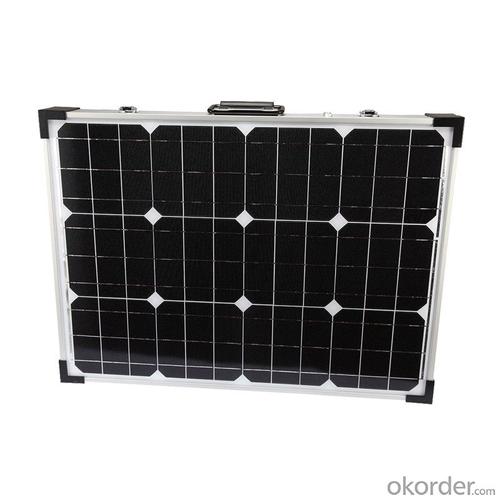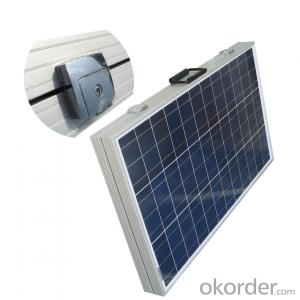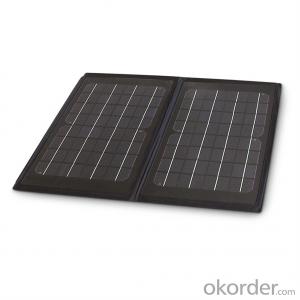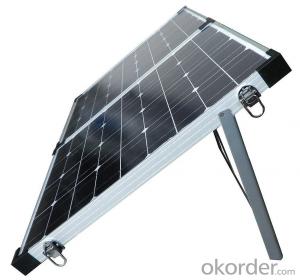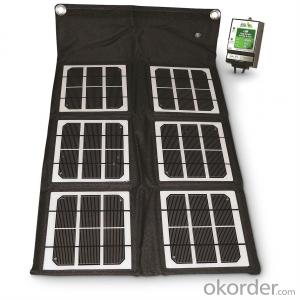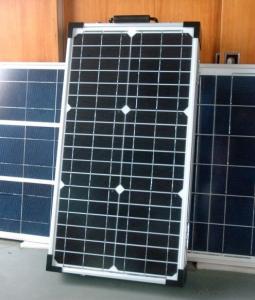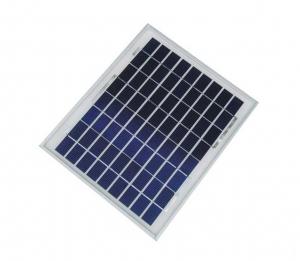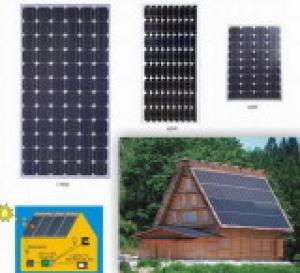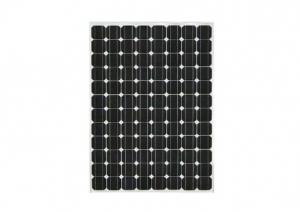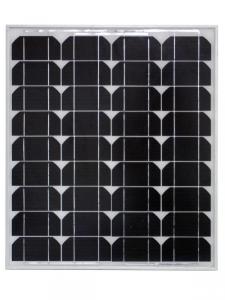Euro Solar Panels 30W Folding Solar Panel with Flexible Supporting Legs for Camping
- Loading Port:
- Shanghai
- Payment Terms:
- TT OR LC
- Min Order Qty:
- 1000 watt
- Supply Capability:
- 10000 watt/month
OKorder Service Pledge
OKorder Financial Service
You Might Also Like
Specification
Product Description
Folding module kits are designed to provide portable 12 volt power wherever you need it.PoPwer available from 20W to 240W
Features:
· Padded, moulded carry bag
· Heavy duty carry handle, hinges and clasps Stainless steel telescopic&adjustable legs
· Weatherproof solar charge controller with LED indicator
· 5m cable with heavy duty Anderson connectors between module-regulator & regulator-battery clamps
· All cabled up ready to use
· 2 year warranty
These kits are the ideal solution for 4WD, camping, caravaning, boating and recreational activities whereverpower is required for lights, small TV, camping fridge, pump or other small appliances.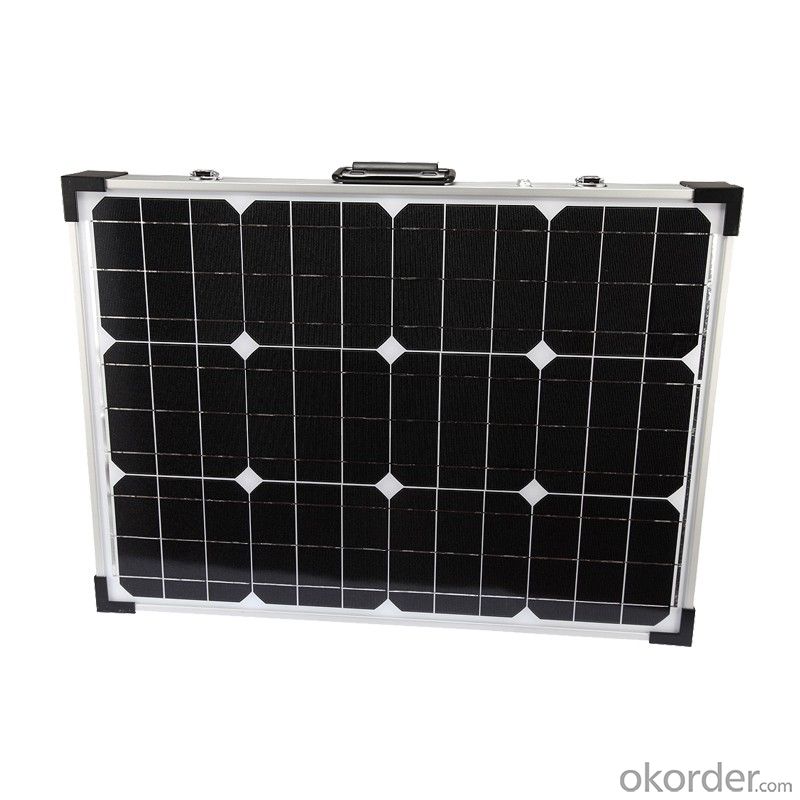
| Nominal Peak Power | 30W | 120W (2 x 60W) | 160W (2 x 80W) | 200W (2 x 100W) |
| Power tolerance | 3% | |||
| Cell type | Monocrystalline/Polycrystalline | |||
| Open circuit voltage (Voc) | 21.6V | |||
| Voltage at maximum power (Vmp) | 17.6V | 17.5V | 17.5V | 17.5V |
| Short circuit current (Isc) | 4.9A | 7.4A | 9.88A | 12.34A |
| Current at maximum power (Imp) | 4.54A | 6.86A | 9.14A | 11.42A |
| Maximum system voltage | 1000VDC | |||
| NOCT (Nominal Operating Cell Temperature) | 45 C +/-2 C | |||
| Operating temperature - module | -40 C to +85 C | |||
| Operating temperature – charge | -35 C to +55 C | |||
| Module folded size (mm) in carry bag | 505x550x60 | 505x825x80 | 505x1005x70 | 670x1005x70 |
| Module open size (mm) | 1014x550x30 | 1014x825x35 | 1014x1005x35 | 1344x1005x35 |
| Module net weight (kg) | 9.2 | 13 | 15.2 | 19 |
| Module gross weight (kg) | 11 | 16 | 19.4 | 23.2 |
| Solar charge controller | PWM 12V 10A; IP65 rated | PWM 12V 20A; IP65 rated | ||
- Q: How do solar panels affect wildlife?
- Solar panels can have both positive and negative effects on wildlife. On the positive side, solar panels can provide a habitat for certain species, such as birds or insects, as they can create shaded areas or serve as perches. Additionally, solar farms often have vegetation underneath or around the panels, which can attract and support a diverse range of wildlife. However, there are also potential negative impacts to consider. Large-scale solar projects can disrupt or destroy natural habitats, leading to the displacement or loss of certain species. Additionally, solar panels can pose a risk to birds and other flying animals if they are not properly designed or installed. Glare from the panels may also impact wildlife behavior or migration patterns. Overall, it is important to carefully plan and manage solar installations to minimize any negative impacts on wildlife while maximizing the benefits they can provide.
- Q: I'm writing a post-apocalyptic story in it the main character finds a warehouse. Eventually he finds out the roof is covered with commercial solar panels. Given it's been over a year since the majority of the world died no manainence was done, do they still work?
- they are in a position to be in case you're properly knowledgeable and experienced of their assembly and working function, offered you acquire the comparable severe high quality grade cells and do perfect assembly. probability is robust although that your first a number of could be in hassle-free terms somewhat below par till you rather get the carry of it and strengthen into properly practiced purely because of the fact the pros are. Does take a important volume of grunt paintings although so determine if it rather is great use of a while or in case you will do greater beneficial to earn at your prevalent paintings and pay a professional to do this which they do superb.
- Q: How can I start working as a solar panel installer/technician without years of education?
- The best suggestion I can give is to call solar installation companies in your area, and ask for their recommendation as to what to do. They may recommend a technical college with an appropriate program. With unemployment rising, new jobs in solar will likely be scarce for a while. You might also inquire at roofing companies. If you apply at a solar company, and can demonstrate that you already have roofing experience, that will be a plus.
- Q: I'm part of the Sustainability group at school, the school principal is a d**k and doesn't care about the environment, he only cares about money.Me and the group will be talking in front of him and the school council (the people in-charge of the school's money) To convince them to put solar panels on the school roofs.I know that it definitely will help the school save on electricity bills, but it WILL cost a lot of money to put them in.In the end we just wanna reduce carbon emissions!HELP :)
- Installing solar cells cost money. It would swamp the capital spending portion of the school budget. I doubt the school board would put it into the budget because of the cost involved. If they did I guarantee you that, when presented to the voters, they would turn down the budget. If you really want to do something, I suggest a fund raiser, but you are probably looking at raising more than $500,000. Good luck.
- Q: Can solar panels be installed on a historical building?
- Yes, solar panels can be installed on a historical building. However, it is important to consider the impact on the building's architectural integrity and historical significance. Careful planning and consultation with preservation experts may be necessary to ensure that the installation is done in a way that respects and preserves the building's historic value.
- Q: I have four power packs for solar lights. They have 3 AA .2volt batteries of 2450 mAh capacity installed in series for a total supply voltage of 4 volt maximum for the lights. I want to charge all four packs at once off a single 6 volt solar panel. With the four packs wired in parallel, what capacity output (wattage) panel do I need to charge the batteries in an 8 hour day?
- Each battery pack has the equivalent of only 2450mAh capacity at 4 volts, so for 4 battery packs like that, a total capacity of 9800mAh. Assuming that the solar batteries have no charge left after being on all night, and that day charging time equals night discharging time, the theoretical wattage would be 9800mA times 6 volts = 59 watts. Of course, battery charging is not 00% efficient, so you need more wattage than that. Plus, solar panels are rated at peak output at midday, while at other times of day their output is less than rated. And, the charging in parallel isn't a good idea, because real batteries have different internal resistances, some batteries would become overcharged, while other packs wouldn't get the charge they need.
- Q: Can solar panels be used for powering an electric fence?
- Yes, solar panels can be used to power an electric fence. Solar panels can generate the necessary electricity to charge the fence's battery, ensuring a constant power supply for the electric fence system.
- Q: How do solar panels affect the energy independence of a building?
- Solar panels can greatly enhance the energy independence of a building by converting sunlight into electricity. By generating their own clean and renewable energy, buildings with solar panels can reduce or even eliminate their dependence on traditional energy sources like fossil fuels or the grid. This not only reduces the carbon footprint but also provides a sustainable and reliable source of power, ultimately granting greater energy independence to the building.
- Q: The inverter I am using gets the required 2 DC volts from the solar panel, but fo some reason it just won't output the 0 AC voltage. When the inverter is hooked to a car battery, it works just fine off the same 2 DC rating. Help me out please...
- There could be a couple of reasons why it isn't working. First, 2V panels actually put out a considerably higher voltage because it is presumed that they will be used to charge a 2Vdc battery. That requires applying a voltage greater than 2Vdc, and usually there is a solar controller that regulates the solar power to the battery. It also has a voltage drop. Look at the first reference reference, and you will see these values for a particular panel: Voc: 2.6V (open circuit voltage) Vmp: 7.2V (voltage at maximum power point) Voc is the voltage the panel produces under standard sunlight and temperature conditions (25°C), with no load applied. As load is applied, the voltage drops (see reference 2). Power is the product of current times voltage, so at one set of conditions (namely at Vmp) maximum power is available from the panel. Your inverter might not be working for either of two reasons: ) it has input protection circuitry that locks out operation when it senses an overvoltage, as in the 2.6V open circuit voltage, or 2) the panel does not produce enough current and the voltage from the panel collapses under excessive load. For example, if you load your inverter to 20W, then nominally the 2VDC input to the inverter must supply 20W/2V/eff = 0A/eff Assuming the inverter has an efficiency of 80%, the input current required is: 0A/.8 = 2.5A A solar panel operating at maximum power would need a rating of about: 2.5A x 7.2V = 25W Is your panel that big? The other option, as mentioned by others, is to charge a battery that runs the inverter. Other nuances: Voc increases as temperature decreases. Sunlight intensity varies (obviously), so the panel may produce less than rated power. The power specifications often are printed on the back side of the panel.
- Q: can i put a solar panel on a projector. if nt wat is a low energy projector that i can watch movies and play games on
- Unlikely to prove useful. Solar panels don't generate very much current. You would probably wind up spending several thousand dollars, and wind up with a solar panel array (including batteries and power inverter) that is certainly not portable. You will also need adequate current for your projection source (ie DVD player or computer), as well as sound. By and large, the cheapest projectors require the least amount of power. There is no way around the fact that, for a projector to be practical, it must output out a great deal of light. Adequate light requires adequate current.
Send your message to us
Euro Solar Panels 30W Folding Solar Panel with Flexible Supporting Legs for Camping
- Loading Port:
- Shanghai
- Payment Terms:
- TT OR LC
- Min Order Qty:
- 1000 watt
- Supply Capability:
- 10000 watt/month
OKorder Service Pledge
OKorder Financial Service
Similar products
Hot products
Hot Searches



